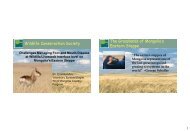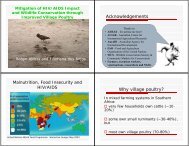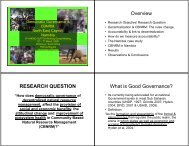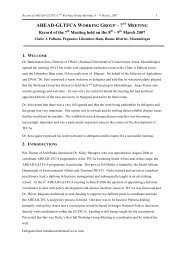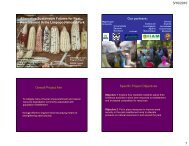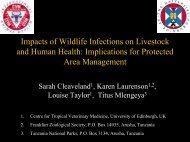The Impact of HIV and AIDS The Impact of HIV and AIDS on ...
The Impact of HIV and AIDS The Impact of HIV and AIDS on ...
The Impact of HIV and AIDS The Impact of HIV and AIDS on ...
You also want an ePaper? Increase the reach of your titles
YUMPU automatically turns print PDFs into web optimized ePapers that Google loves.
<str<strong>on</strong>g>The</str<strong>on</strong>g> <str<strong>on</strong>g>Impact</str<strong>on</strong>g> <str<strong>on</strong>g>of</str<strong>on</strong>g> <str<strong>on</strong>g>HIV</str<strong>on</strong>g> <str<strong>on</strong>g>and</str<strong>on</strong>g> <str<strong>on</strong>g>AIDS</str<strong>on</strong>g><strong>on</strong> Agriculture <str<strong>on</strong>g>and</str<strong>on</strong>g> FoodSecurity: Focus <strong>on</strong> householdvulnerabilityA Case study in Limpopo Province, South AfricaDefiniti<strong>on</strong> in c<strong>on</strong>text• Household vulnerability is the extent to which<str<strong>on</strong>g>HIV</str<strong>on</strong>g>/<str<strong>on</strong>g>AIDS</str<strong>on</strong>g> <str<strong>on</strong>g>and</str<strong>on</strong>g> other factors affect ahousehold’s s food security status, <str<strong>on</strong>g>and</str<strong>on</strong>g> thehousehold’s ability or inability to withst<str<strong>on</strong>g>and</str<strong>on</strong>g> theshock caused by these factorsP.Chaminuka, L.K. Debusho, F. Anim & S.NqangweniUniversity <str<strong>on</strong>g>of</str<strong>on</strong>g> Limpopo <str<strong>on</strong>g>and</str<strong>on</strong>g> University <str<strong>on</strong>g>of</str<strong>on</strong>g> Pretoria3/17/2008 2Background• One-third<str<strong>on</strong>g>of</str<strong>on</strong>g> the global populati<strong>on</strong> living with<str<strong>on</strong>g>HIV</str<strong>on</strong>g> is in sub-SaharanAfrica.• SA hosts about 5 milli<strong>on</strong> people living with<str<strong>on</strong>g>HIV</str<strong>on</strong>g>/<str<strong>on</strong>g>AIDS</str<strong>on</strong>g>, at least 250,000000 die each year• About 35% <str<strong>on</strong>g>of</str<strong>on</strong>g> South Africa’s populati<strong>on</strong> isestimated to be vulnerable to food insecurity(de Klerk, et al., 2004).• Agriculture <str<strong>on</strong>g>and</str<strong>on</strong>g> related industries c<strong>on</strong>tributesabout 13% to GDP <str<strong>on</strong>g>and</str<strong>on</strong>g> provide livelihoods toabout 40% <str<strong>on</strong>g>of</str<strong>on</strong>g> populati<strong>on</strong>.<str<strong>on</strong>g>The</str<strong>on</strong>g> Problem• Lack <str<strong>on</strong>g>of</str<strong>on</strong>g> quantitative data <strong>on</strong> impacts, mostlydescriptive in nature <str<strong>on</strong>g>and</str<strong>on</strong>g> reliant <strong>on</strong> crosssecti<strong>on</strong>al analysis.• Existing data does not allow comparis<strong>on</strong> withother states in the SADC regi<strong>on</strong> to facilitatecollective acti<strong>on</strong> at regi<strong>on</strong>al level.• Extent <str<strong>on</strong>g>of</str<strong>on</strong>g> impact not differentiated i d betweengroups <str<strong>on</strong>g>of</str<strong>on</strong>g> households
Research Objectives• Investigate the impacts <str<strong>on</strong>g>of</str<strong>on</strong>g> the p<str<strong>on</strong>g>and</str<strong>on</strong>g>emic <strong>on</strong>agricultural producti<strong>on</strong> <str<strong>on</strong>g>and</str<strong>on</strong>g> household foodsecurity.• Determine the vulnerability <str<strong>on</strong>g>of</str<strong>on</strong>g> households t<str<strong>on</strong>g>of</str<strong>on</strong>g>ood insecurity <str<strong>on</strong>g>and</str<strong>on</strong>g> estimate the extent towhich <str<strong>on</strong>g>HIV</str<strong>on</strong>g>/<str<strong>on</strong>g>AIDS</str<strong>on</strong>g> affects the vulnerability <str<strong>on</strong>g>of</str<strong>on</strong>g>households.• Describemitigati<strong>on</strong> <str<strong>on</strong>g>and</str<strong>on</strong>g> coping strategiesadopted by households
3/17/2008 6
STUDY AREA AND METHODOLOGY• Area- Capricorn District, Limpopo Province,South Africa.• Purposive selecti<strong>on</strong> <str<strong>on</strong>g>of</str<strong>on</strong>g> villages• Seven Villages,• N<strong>on</strong> affected- (100hhlds)• Affected (118hhlds)- Morbidity- Mortality- Hybrid• Stratificati<strong>on</strong>, 240 households• Surveys, Focussed Group Discussi<strong>on</strong>s• Descriptive statisticsttitiDATA ANALYSIS• Multiple linear regressi<strong>on</strong>• Multiple LOGIT• ANOVA• <str<strong>on</strong>g>The</str<strong>on</strong>g> Household vulnerability index (HVI) - todeterminetheextenttowhichdifferenthouseholds are vulnerable to food insecurity.HVI Computati<strong>on</strong>• Variables from the survey data grouped intodifferent clusters corresp<strong>on</strong>ding to the impactareas <str<strong>on</strong>g>of</str<strong>on</strong>g> <str<strong>on</strong>g>HIV</str<strong>on</strong>g>/<str<strong>on</strong>g>AIDS</str<strong>on</strong>g>.• Four main dimensi<strong>on</strong>s <str<strong>on</strong>g>of</str<strong>on</strong>g> the livelihood assetsaffected are• Human capital• financial capital• social capita <str<strong>on</strong>g>and</str<strong>on</strong>g>• physical py capital56.054.052.050.0% hholds48.046.044.042.040.0Research FindingsAffected N<strong>on</strong> affected Total sampleCategoryMaleFemale3/17/2008 9
Findings c<strong>on</strong>tinuedFindings: <str<strong>on</strong>g>HIV</str<strong>on</strong>g>/<str<strong>on</strong>g>AIDS</str<strong>on</strong>g> <str<strong>on</strong>g>and</str<strong>on</strong>g> household income <str<strong>on</strong>g>and</str<strong>on</strong>g> expenditureKey indicators meanHousehold categoryNot Affected Illness DeathDependency ratio 0.44 0.45 0.45Hours lost per household0.34 6.24 7.13per dayPurchased Agricultural R194.94 R135.28 R106.85InputsLabour input intoagriculture8.55 hours 7.87 hours 7.30 hoursCultivated l<str<strong>on</strong>g>and</str<strong>on</strong>g> area 2004 1.433 ha 1.103 ha 1.060 haChange in l<str<strong>on</strong>g>and</str<strong>on</strong>g> under0.025 ha -0.173 ha -0.446 hacultivati<strong>on</strong> 2003-20042004Maize produced in t<strong>on</strong>nes 0.487 0.410 0.362AverageIncome <str<strong>on</strong>g>of</str<strong>on</strong>g> thehousehold peradultNot AffectedHousehold categoryR311Mdi Medical expenditureR306per household/yrFood ExpenditureEducati<strong>on</strong>expenditureR4538R761IllnessR306R1114R4179R623DeathR245R2290R3955R440HOUSEHOLD VULNERABILITY ANALYSIS• <str<strong>on</strong>g>The</str<strong>on</strong>g> aggregated levels <str<strong>on</strong>g>of</str<strong>on</strong>g> vulnerability used in theanalysis are;• Coping Households (CHH) – a household in vulnerablesituati<strong>on</strong> but still able to cope• Acute Level households (ALH) – a household that hasbeen hit so hard that it badly needs assistance to the degree<str<strong>on</strong>g>of</str<strong>on</strong>g> an acute health care unit in hospital. With some rapid-resp<strong>on</strong>se type <str<strong>on</strong>g>of</str<strong>on</strong>g> assistance the family may be resuscitated.t • Emergency Level Households (ELH) – the equivalent <str<strong>on</strong>g>of</str<strong>on</strong>g>an intensive care situati<strong>on</strong> – almost a point <str<strong>on</strong>g>of</str<strong>on</strong>g> no return –but could be resuscitated <strong>on</strong>ly with the best possibleexpertiseHousehold Vulnerability IndexHVI level HVI RangeSituati<strong>on</strong> <str<strong>on</strong>g>of</str<strong>on</strong>g>Household Freq PercentVulnerability 00 0.0 – 33.3% 3% Coping63 28.9Level 1-CHouseholds(CHH)VulnerabilityLevel 2-A33.4 – 66.7% Acute Levelhouseholds (ALH)153 70.2Vulnerability66.8 –100% Emergency Level2 09 0.9Level 3-EHouseholds (ELH)Total 218 100.03/17/2008 133/17/2008 14
Reas<strong>on</strong>s for high vulnerability• Social grants thinly spread• Low maize yields – dry area• High unemployment• Few livestock• Transitory <str<strong>on</strong>g>and</str<strong>on</strong>g> chr<strong>on</strong>ic household foodinsecurityCoping <str<strong>on</strong>g>and</str<strong>on</strong>g> Mitigati<strong>on</strong> Strategies• Hiring <str<strong>on</strong>g>of</str<strong>on</strong>g> labour• Seeking remittances from n<strong>on</strong>-residentmembers <str<strong>on</strong>g>and</str<strong>on</strong>g> relatives• Food parcels• Assistance from home based care groups• Seeking social grants• Selling cattle3/17/2008 15Why <str<strong>on</strong>g>HIV</str<strong>on</strong>g>/<str<strong>on</strong>g>AIDS</str<strong>on</strong>g> within AHEAD?• Cross cutting issue-huge social & ec<strong>on</strong>omicimplicati<strong>on</strong>s• Labour impact- Livestock systems, L<str<strong>on</strong>g>and</str<strong>on</strong>g> usepossibilities, i Increased dependency d <strong>on</strong> naturalresources• Animal health expenditure sec<strong>on</strong>d to human healthexpenditure• Look at diseases ses such as TB bey<strong>on</strong>d thewildlife/livestock interface- C<strong>on</strong>cept <str<strong>on</strong>g>of</str<strong>on</strong>g> ONEHEALTH3/17/2008 17



